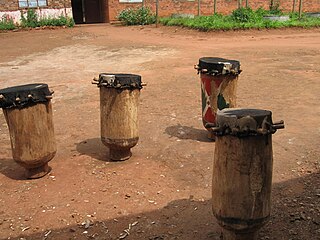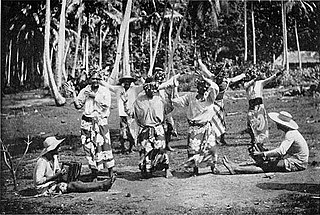
Maxwell Lemuel Roach was an American jazz drummer and composer. A pioneer of bebop, he worked in many other styles of music, and is generally considered one of the most important drummers in history. He worked with many famous jazz musicians, including Clifford Brown, Coleman Hawkins, Dizzy Gillespie, Charlie Parker, Miles Davis, Duke Ellington, Thelonious Monk, Abbey Lincoln, Dinah Washington, Charles Mingus, Billy Eckstine, Stan Getz, Sonny Rollins, Eric Dolphy, and Booker Little. He also played with his daughter Maxine Roach, Grammy nominated Violist. He was inducted into the DownBeat Hall of Fame in 1980 and the Modern Drummer Hall of Fame in 1992.
The music of Martinique has a heritage which is intertwined with that of its sister island, Guadeloupe. Despite their small size, the islands have created a large popular music industry, which gained in international renown after the success of zouk music in the later 20th century. Zouk's popularity was particularly intense in France, where the genre became an important symbol of identity for Martinique and Guadeloupe. Zouk's origins are in the folk music of Martinique and Guadeloupe, especially Martinican chouval bwa, and Guadeloupan gwo ka. There's also notable influence of the pan-Caribbean calypso tradition and Haitian kompa.

A djembe or jembe is a rope-tuned skin-covered goblet drum played with bare hands, originally from West Africa. According to the Bambara people in Mali, the name of the djembe comes from the saying "Anke djé, anke bé" which translates to "everyone gather together in peace" and defines the drum's purpose. In the Bambara language, "djé" is the verb for "gather" and "bé" translates as "peace."

Bow Wow Wow are an English new wave band, created by manager Malcolm McLaren in 1980. McLaren recruited members of Adam and the Ants to form the band with then 13-year-old Annabella Lwin on lead vocals. They released their debut EP Your Cassette Pet in 1980 and had their first UK top 10 hit with "Go Wild in the Country" in 1982. The band's music was characterized by a danceable new wave sound that drew on a Burundi beat provided by Dave Barbarossa on drums, as well as the subversive, suggestive, and sometimes exuberant lyrics sung and chanted by their teenage lead vocalist.

WOMAD is an international arts festival. The central aim of WOMAD is to celebrate the world's many forms of music, arts and dance.

The karyenda is a traditional African drum. It was the main symbol of Burundi and its Mwami (King) and had semi-divine status. The Mwami was said to interpret the beatings of the karyenda into rules for the kingdom.
Chouval bwa is a kind of folk music originated on the slave plantations of Martinique. There are two versions, traditional and modern. Chouval bwa has been popularized by artists such as Claude Germany, Tumpak, Dede Saint-Prix, and Pakatak.

Glen Velez is a four-time Grammy winning American percussionist, vocalist, and composer, specializing in frame drums from around the world. He is largely responsible for the increasing popularity of frame drums in the United States and around the world. Velez is married to Loire.

In many parts of sub-Saharan Africa, the use of music is not limited to entertainment: it serves a purpose to the local community and helps in the conduct of daily routines. Traditional African music supplies appropriate music and dance for work and for religious ceremonies of birth, naming, rites of passage, marriage and funerals. The beats and sounds of the drum are used in communication as well as in cultural expression.
A bélé is a folk dance and music from Dominica, St. Lucia, Martinique, Haiti, Grenada, Guadeloupe, and Trinidad and Tobago. It may be the oldest Creole dance of the creole French West Indian Islands, and it strongly reflects influences from African fertility dances. It is performed most commonly during full moon evenings, or sometimes during funeral wakes. The dance is also popular in Saint Lucia. In Tobago, it is thought to have been performed by women of the planter class at social events in the planters' great houses, and the dress and dance style copied by the enslaved people who worked in or around these houses.

Famoudou Konaté is a Malinké master drummer from Guinea. Famoudou Konaté is a virtuoso of the djembe drum and its orchestra. One of only a handful of initiated masters of the Malinké drumming tradition, Famoudou is universally respected as one of the world's premiere djembe master drummers. He has dedicated his life to performing and preserving the music of his people, helping to elevate the djembe orchestra from its traditional roots to worldwide popularity.

Les Tambours du Bronx are a French industrial percussion band formed in 1987.
DanceAfrica is a heritage and community celebration equable on the manifold dance forms of the African Diaspora held annually in New York City, Washington, DC, and Chicago. Included are indoor and outdoor performance including live music, a film series, master classes, education programs, and an outdoor bazaar. Its current artistic director is Abdel R. Salaam.
Dances centered around drums are performed in many cultures. Anthropologists sometimes refer to these as "drum dances". Drum dances may have various kinds of spiritual or social significance.
Daihachi Oguchi was a Japanese drummer best known for popularizing taiko.

Gendang beleq is a dance and music performance from Lombok island, Indonesia. It is a popular performance among the native Sasak people.

Tahitian drumming is a style of drumming native to Tahiti and French Polynesia. Tahitian drumming and dance have become symbols of Polynesian heiva to the western world. Heiva is the Tahitian term for entertainment. This authentic performance symbolizes the past and present state of social hierarchies within the community and the island. There has been a significant amount of change to Tahitian drum dancing within the past fifty years. These changes have come from many different aspects of Polynesian society. However, many of them stem from the broader outreach of this tradition to the rest of the world. This music has served as inspiration for many other styles across the globe, especially in other areas of the Pacific.

Max Pollak is percussive dancer and World Music expert. He was born in Vienna, Austria and became known for his work in percussive dance, World Music, tap dance, and choreography. He created "RumbaTap", which merged American Rhythm Tap with Afro-Cuban music and dance. He is the only non-Cuban member of the Afro-Cuban Rumba and folklore ensemble Los Muñequitos de Matanzas. For the 19th and early 20th centurygraphic artist, Max Pollak, see http://www.artnet.com/artists/max-pollak/
Alfons Grieder was a Swiss rudimental drummer who spread awareness of the Basel Drumming style in America during the mid to late 20th century through his traveling, teaching, and publications.

The Ritual dance of the royal drum is a drumming tradition from Burundi that combines synchronised drumming with dancing and traditional songs. In 2014, it was added to the Representative List of the Intangible Cultural Heritage of Humanity by UNESCO.













